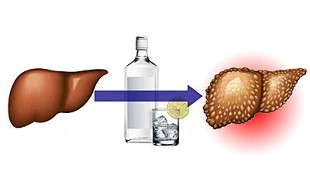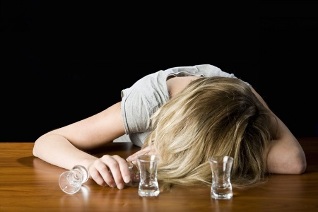The most well-known consequence of alcohol consumption is liver disease. There are many myths about the dangers of drinking vodka, beer or wine. All alcoholic beverages contain ethanol, a potentially toxic substance, so there is no small or beneficial dose.
Negative consequences of drinking alcohol, even in small doses, are possible, but over a longer period of time.Why is alcohol not good for your health?
If alcohol is consumed frequently and excessively, alcohol can cause not only addiction, but can also be the cause of many organic diseases. Ethanol itself, and its elements that appear during the production of alcoholic beverages, can be harmful to health.
The following organs are most often affected:
- liver (alcoholic liver steatosis, hepatitis, liver cirrhosis);
- stomach (stomach ulcer, dyspepsia);
- colon (colon cancer);
- pancreas (pancreatitis).
Alcohol is very toxic and addictive. Therefore, it is very difficult for many people to stop drinking immediately and without consequences. The lethal dose of ethanol is about 8 g per 1 kg of body weight. Therefore, when drinking beer, vodka or drinks, you need to remember about simplification, both in terms of quantity and frequency of use. Alcohol is a source of so-called empty calories. Consumption in large amounts causes overweight (1 g of ethanol-7 kcal).
Alcoholic beverages contribute to the development of various diseases and exacerbate existing symptoms.
Therefore, should be drunk in small amounts, you can choose drinks that are potentially less harmful. You should also be careful with certain compounds that exacerbate ethanol toxicity. But despite adhering to this rule, the negative consequences of drinking will sooner or later make them feel.
What determines the dangers of alcohol?
The effects of alcohol on the body depend on various factors. What matters is the type and amount of ethanol consumed, gender, genetic factors, time and method of use, the type of medication used, and overall health. Similarly, the effectiveness of alcoholism treatment depends.
Consumption of alcohol and tobacco simultaneously has a very harmful effect on the body.
The strong link between alcohol and development has been proven:
- oral tumor;
- neoplasm tonsils;
- throat cancer.

The risk of developing this tumor increases by 30% in people who drink alcohol. At that time, if alcohol is combined with smoking, the risk is tripled. Consuming alcohol and smoking at the same time increases the risk of the negative effects of alcohol and severe intoxication.
One of the common mistakes in the development of intoxication is drinking alcohol on an empty stomach. This accelerates the absorption of alcohol, and also causes an increase in symptoms of intoxication the next day.
The various flavors used, for example, to prepare drinks, as well as combine many types of alcoholic beverages, also contribute to the occurrence of intoxication. The smallest hangover occurs after consuming high quality and good vodkas.
Ethanol poisoning can also occur in cases of alcohol abuse. The symptoms are:
- nausea and vomiting;
- dizziness;
- diarrhea;
- dehydration.
Safe drink - what does it mean?
A number of scientific studies (from various centers around the world) report the beneficial effects of alcohol in very small amounts on the function of individual organs.
A small amount of alcohol is between 20 to 40 grams of pure ethyl alcohol. Roughly we can say that this is:
- a small bottle of beer;
- a glass of wine;
- 40 ml vodka.
Recommendations should not be considered as an incentive to drink alcoholic beverages, much less for normal daily use. Keep in mind about the negative consequences of alcohol consumption, albeit to a lesser extent, which can lead to drug addiction.
Many beer and wine drinkers can be tricked into learning safe amounts of alcohol.
A reasonable daily dose has been agreed, which theoretically should not have a negative effect on the human body, for the woman is 20 g of alcohol a day, which corresponds to a small can of beer or a glass of wine. In turn, for men, 40 g of alcohol a day. This restriction assumes use no more than 5 times a week. Even so, these quantities can be addictive and pose a serious danger to health.
Keep in mind that it is easier for women to become addicted to alcohol than men. They also have a slower metabolic process for alcohol intake. A woman consumes the same amount of alcohol, her concentration in the blood reaches a higher level than a man.
Can alcohol have a positive effect?
No matter what type of alcohol each person drinks and in what quantity. Even overdosing on doses that are recognized as safe, can still cause illness and drug addiction. They say that it is never too late to stop drinking, however, the sooner you do it, the better. Therefore, you can avoid its negative effects on the whole body.
A number of studies show that a small amount of alcohol consumed daily increases the amount of good HDL cholesterol. HDL particles work more positively than bad cholesterol (LDL). This is considered the only way to get rid of cholesterol owned by the body.
It should be noted here again that the role played by alcohol is an exception and is only used in very small doses. A small amount of alcohol does not affect total cholesterol. According to research data, excessive alcohol intake leads to an increase in total cholesterol parameters.
You can often read about the health benefits of drinking wine and beer. In fact, it contains several substances that can have a positive effect on the body. For example, quercetin and resveratrol, found in red wine, have a beneficial effect on the heart and vascular system. This is an antioxidant called.
However, other unsafe foods are also a source of antioxidants: red grapes, berries, apples, nuts. The negative consequences of alcohol consumption here will be much better than good.
How many calories and what ingredients are in an alcoholic beverage?
Grapes contain 8. 5-18% ethanol. The caloric content of wine depends on its type. Sweet wine has the most calories (about 94-104 kcal per 100 g). Minimum calories supplied by dry wine (65-68 kcal per 100 g). The wine contains including:
- flavonoid;
- tanin;
- organic acid;
- calcium;
- potassium;
- phosphorus;
- magnesium;
- hardware;
- vitamin group B.
Red and dried grapes are among the most harmless and low in calories and have the most antioxidants. Although the content of many valuable compounds is quite high, wine is an alcoholic beverage that contains pure ethanol. This means that the negative effects of alcohol consumption even in this form are possible.

The alcohol content in beer is very diverse - from 0. 2 to 9-10%. Beer, of course, has about 49 kcal per 100 g, dark beer, in turn, has more calories, because in 100 g about 68 kcal.
Beer contains, in particular, antioxidants and B vitamins, magnesium, potassium, phosphorus. You can get a lot of information about the beneficial effects of beer on the urinary system. But beer is also a source of ethanol. There is a good effect on the urinary system, but this does not overcome the loss to the body.Vodka, liquor, high quality cognac contains the most ethyl alcohol - from 15 to 80%. They are also high in calories, vodka contains about 220 kcal per 100 g.
In alcohol in any minimum dose, it still has a detrimental effect on the whole body. Do not be surprised by the false facts about the benefits of alcoholic beverages. Alcohol is clearly an unnecessary substance, and sometimes dangerous in terms of organ and system function. The treatment of alcoholism is a very complex and often lengthy procedure that requires the special efforts of patients, relatives and medical staff. The negative consequences of drinking alcohol will be much more serious than the pleasure of drinking for a while.
























